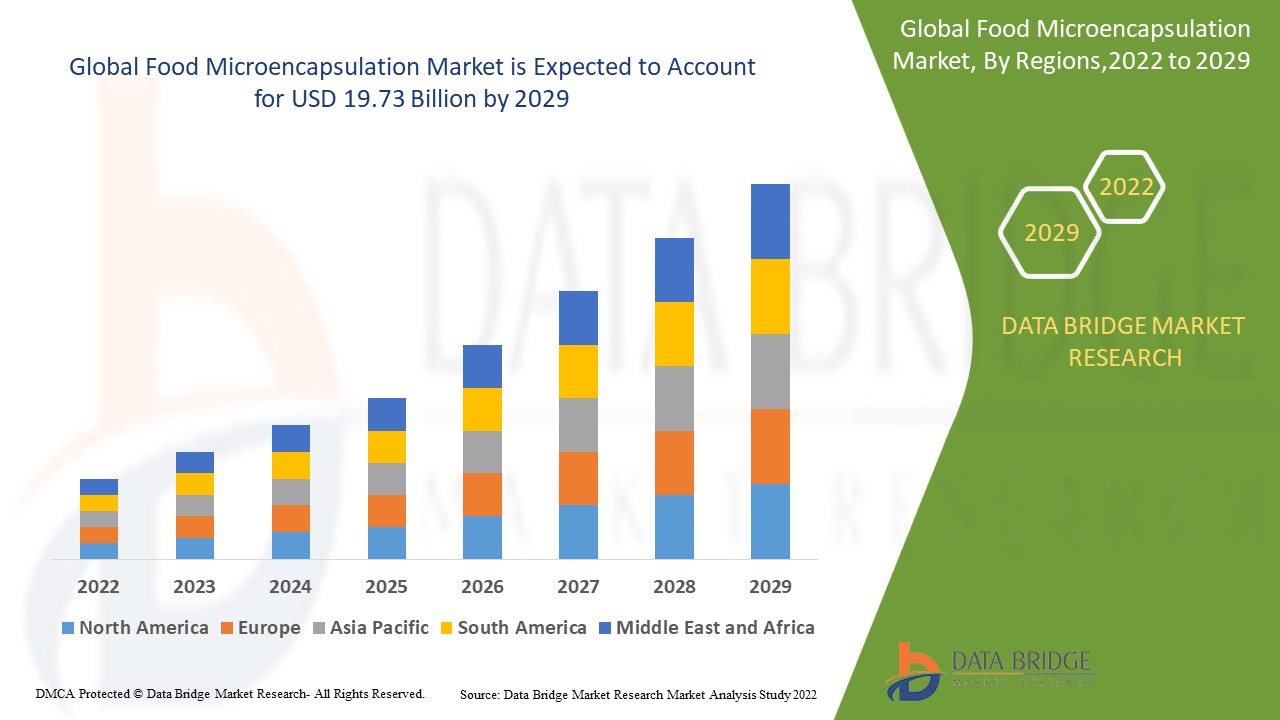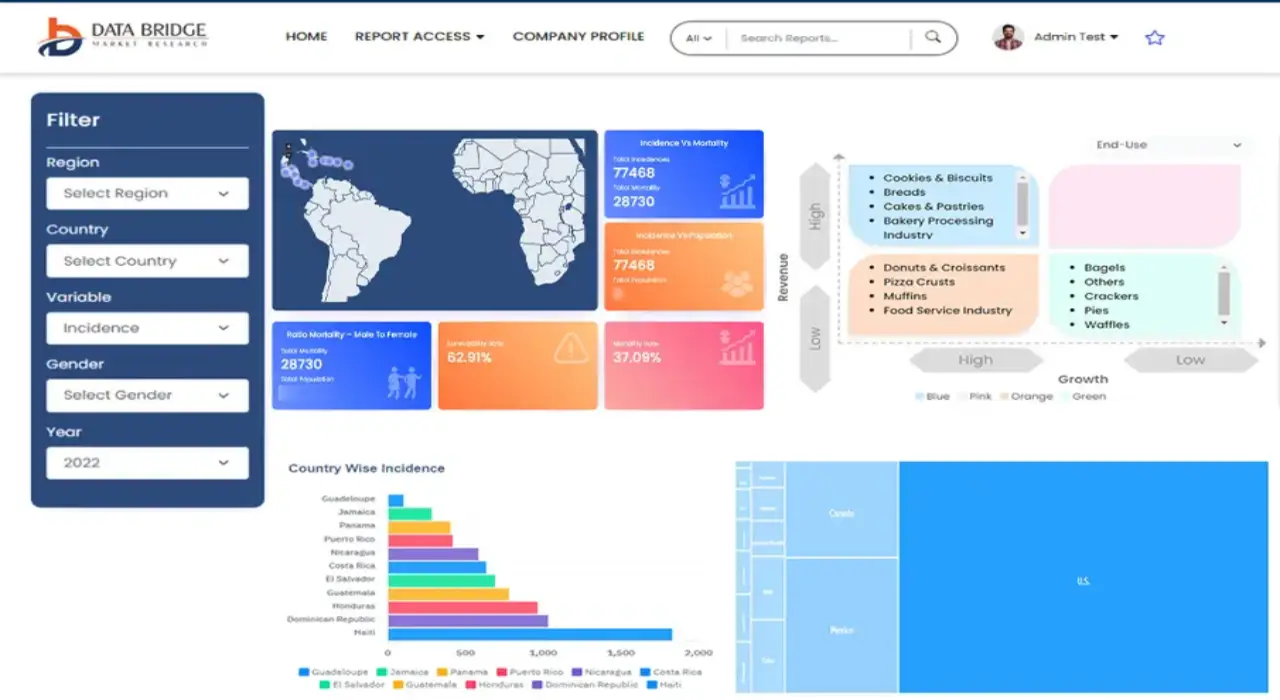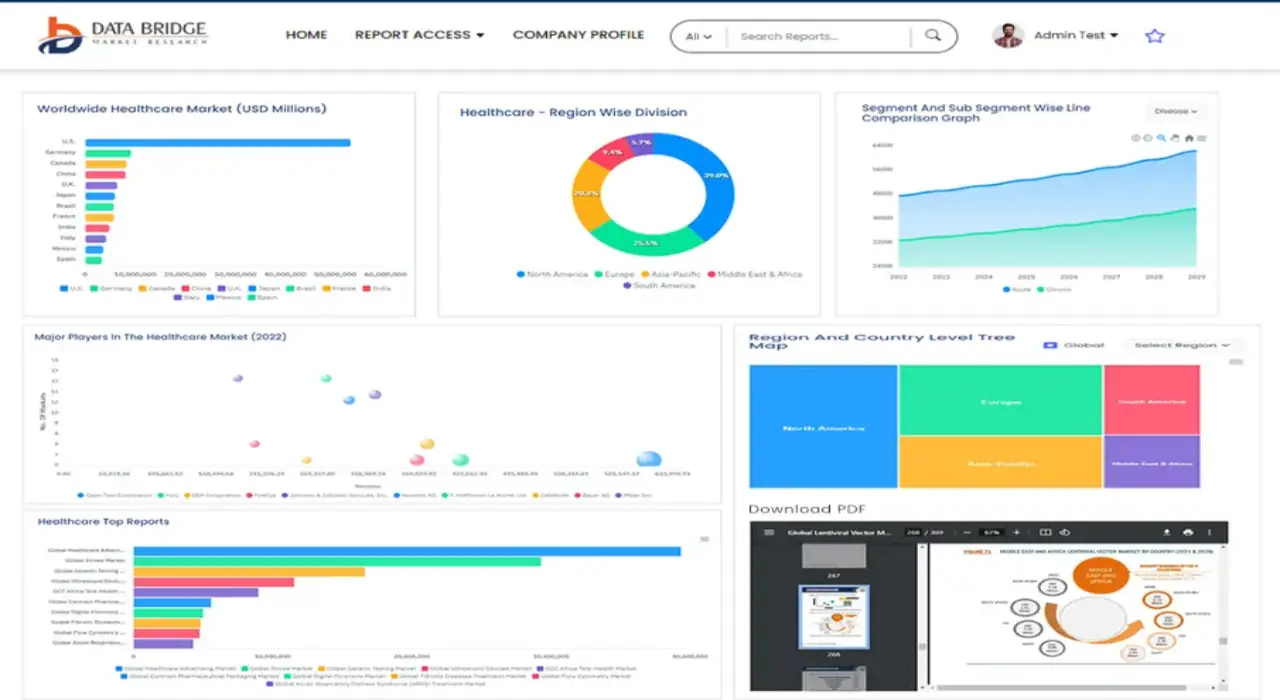Global Food Microencapsulation Market
市场规模(十亿美元)
CAGR :
% 
 USD
10.90 Billion
USD
19.73 Billion
2021
2029
USD
10.90 Billion
USD
19.73 Billion
2021
2029
| 2022 –2029 | |
| USD 10.90 Billion | |
| USD 19.73 Billion | |
|
|
|
>Global Food Microencapsulation Market, By Technology (Spray, Emulsion and Dripping), Core Material (Pharmaceutical & Healthcare Drugs and Others), Shell Material (Polymers, Gums & Resins and Others), Application (Pharmaceutical & Health Care Products, Home & Personal Care, Food & Beverages, Agrochemicals, Construction, Textile) – Industry Trends and Forecast to 2029.

Food Microencapsulation Market Analysis and Size
Encapsulation technology is becoming increasingly important in a variety of industries, including biomedical diagnostics, food, cosmetics, and drug therapy. The Microencapsulation industry has the potential to deliver nutrients to the body that are difficult to obtain by including them in fortified or functional food products. The technology is also being used to improve the bioavailability and delivery of nutraceuticals, which have been shown to have therapeutic and disease-prevention properties.
Data Bridge Market Research analyses that the food microencapsulation market was valued at a USD 10.9 billion in 2021 is expected to reach the value of USD 19.73 billion by 2029, at a CAGR of 7.70% during the forecast period of 2022-2029. In addition to the insights on market scenarios such as market value, growth rate, segmentation, geographical coverage, and major players, the market reports curated by the Data Bridge Market Research also include in-depth expert analysis, geographically represented company-wise production and capacity, network layouts of distributors and partners, detailed and updated price trend analysis and deficit analysis of supply chain and demand.
Food Microencapsulation Market Scope and Segmentation
|
Report Metric |
Details |
|
Forecast Period |
2022 to 2029 |
|
Base Year |
2021 |
|
Historic Years |
2020 (Customizable to 2014 - 2019) |
|
Quantitative Units |
Revenue in USD Billion, Volumes in Units, Pricing in USD |
|
Segments Covered |
Technology (Spray, Emulsion and Dripping), Core Material (Pharmaceutical & Healthcare Drugs and Others), Shell Material (Polymers, Gums & Resins and Others), Application (Pharmaceutical & Health Care Products, Home & Personal Care, Food & Beverages, Agrochemicals, Construction, Textile) |
|
Countries Covered |
U.S., Canada and Mexico in North America, Germany, Sweden, Poland, Denmark, France, U.K., Netherlands, Switzerland, Belgium, Russia, Italy, Spain, Turkey, Rest of Europe in Europe, China, Japan, India, South Korea, Singapore, Malaysia, Australia, Thailand, Indonesia, Philippines, Rest of Asia-Pacific (APAC) in the Asia-Pacific (APAC), Saudi Arabia, U.A.E, South Africa, Egypt, Israel, Rest of Middle East and Africa (MEA) as a part of Middle East and Africa (MEA), Brazil, Argentina and Rest of South America as part of South America |
|
Market Players Covered |
Cargill, Incorporated (U.S.), BASF SE (Germany), DuPont (U.S.), DSM (Netherlands), FrieslandCampina (Netherlands), Kerry Group plc (Ireland), Ingredion (Switzerland), International Flavors & Fragrances Inc. IFF (U.S.), Symrise (Germany), Sensient Technologies Corporation (U.S.), Blachem Inc. (U.S.), Firmenich S.A. (Switzerland), Vitablend (Netherlands), Advanced Bionutrition Corp (U.S.), Encpasys LLC (U.S.), Clextral (France), Sphera Encapsulation (Italy), Aveka (U.S.), Lycored (Israel), and Tastetech (U.K.) |
|
Opportunities |
|
Market Definition
Microencapsulation is a technique in which liquid, solid, or gaseous active ingredients are packaged within another material to protect or shield the active ingredient from its surroundings. This method is useful for increasing the stability of thermochromic mixtures.
Food Microencapsulation Market Dynamics
Drivers
- growing application of microencapsulation techniques in a variety of fields
Encapsulation technology is becoming increasingly important in a variety of fields, including drug therapy, biomedical diagnostics, cosmetics, and food. Due to their outstanding features and benefits, nano-encapsulation and microencapsulation techniques are increasingly being developed and used in a wide range of industries. These benefits typically include superior bioavailability of compounds in drug delivery systems given that approximately half of all drugs produced have issues with poor bioavailability. Innovative microencapsulation techniques promote such advantages and have modulated particle densities to meet specifications for lightweight and porous materials.
- The high dependence of microencapsulation technology in food and beverage industry
Microencapsulation is a nanotechnology application that is well-known in the pharmaceutical industry but has significant potential in the food industry. Despite being a relatively new technology, Microencapsulation has quickly established a strong reputation and is now one of the most widely used in the food industry. Microencapsulation has been used in a variety of food applications over the last few years, including food transportation, food storage, food production, food packaging, and food processing.
Opportunity
The growing economies and technological advancements are attributed to the high growth opportunities for the food encapsulation market in emerging regions. Introducing new encapsulation technologies, such as microencapsulation and bio-encapsulation, is driving the demand for encapsulation in various food applications. Many food products benefit from encapsulation in terms of taste. Manufacturers in the food industry are focusing on innovative developments in encapsulation processes that will aid in product differentiation, value addition, and ensuring the safety of food products while retaining their taste. The advancement of microencapsulation results in smaller bioactive agents with increased bioavailability. Cost savings result from the innovation of these processes, providing an incentive for the adoption of food encapsulation.
Restraints
The rising cost of the microencapsulation process and the availability of substitutes, among other factors, are major restraints that will further challenge the food microencapsulation market during the forecast period.
This microencapsulation market report provides details of new recent developments, trade regulations, import-export analysis, production analysis, value chain optimization, market share, impact of domestic and localized market players, analyses opportunities in terms of emerging revenue pockets, changes in market regulations, strategic market growth analysis, market size, category market growths, application niches and dominance, product approvals, product launches, geographic expansions, technological innovations in the market. To gain more info on the microencapsulation market contact Data Bridge Market Research for an Analyst Brief, our team will help you take an informed market decision to achieve market growth.
Impact and Current Market Scenario of Raw Material Shortage and Shipping Delays
Data Bridge Market Research offers a high-level analysis of the market and delivers information by keeping in account the impact and current market environment of raw material shortage and shipping delays. This translates into assessing strategic possibilities, creating effective action plans, and assisting businesses in making important decisions.
Apart from the standard report, we also offer in-depth analysis of the procurement level from forecasted shipping delays, distributor mapping by region, commodity analysis, production analysis, price mapping trends, sourcing, category performance analysis, supply chain risk management solutions, advanced benchmarking, and other services for procurement and strategic support.
COVID-19 Impact on Food Microencapsulation Market
The COVID-19 pandemic is expected to significantly impact the microencapsulation market due to supply chain disruptions. Polysaccharides, proteins, lipids, and emulsifiers are important raw materials and formulations in the food microencapsulation market. Europe imports a large amount of raw materials from Asia Pacific. International border closures and trade barriers have halted all imports and exports, disrupting the manufacturing process. Asia Pacific countries, including India and China, are home to a slew of small-scale emerging microencapsulation companies. These businesses source raw materials locally and export finished goods to domestic and international markets. Government regulations concerning transportation bans have resulted in short-term disruptions in the transportation of finished goods to market.
Expected Impact of Economic Slowdown on the Pricing and Availability of Products
When economic activity slows, industries begin to suffer. The forecasted effects of the economic downturn on the pricing and accessibility of the products are taken into account in the market insight reports and intelligence services provided by DBMR. With this, our clients can typically keep one step ahead of their competitors, project their sales and revenue, and estimate their profit and loss expenditures.
Recent Development
- BASF SE and Sandoz GmbH, a Novartis subsidiary, have agreed to invest at the Kundl/Schaftenau Campus in Austria in April 2021. This agreement allows BASF SE to expand its enzymes and biotechnology products manufacturing footprint.
- Kerry announced in May 2021 that it will build a purpose-built food technology and innovation centre of excellence in Queensland, Australia.
- Cargill Incorporated will invest USD 100 million in its Indonesian sweetener plant in October 2019 to construct a corn wet mill with a starch dryer to increase starch and sweetener production.
- In November 2018, the company invested Euro 50 million in a new natural food ingredient manufacturing site in Georgia, US, to improve production facilities in the U.S.
Global Food Microencapsulation Market Scope
The food microencapsulation market is segmented on the basis of technology, core material, shell material & application. The growth amongst these segments will help you analyse meagre growth segments in the industries and provide the users with a valuable market overview and market insights to help them make strategic decisions for identifying core market applications.
Technology
- Spray
- Emulsion
- Dripping
Core material
- Pharmaceutical
- Healthcare Drugs
- Others
Shell material
- Polymers
- Gums & Resins
- Others
Application
- Pharmaceutical
- Health Care Products
- Home
- Personal Care
- Food & Beverages
- Agrochemicals
- Construction
- Textile
Food Microencapsulation Market Regional Analysis/Insights
The food microencapsulation market is analysed and market size insights and trends are provided by country, shell material, method, application and core phase as referenced above.
The countries covered in the food microencapsulation market report are U.S., Canada and Mexico in North America, Germany, France, U.K., Netherlands, Switzerland, Belgium, Russia, Italy, Spain, Turkey, Rest of Europe in Europe, China, Japan, India, South Korea, Singapore, Malaysia, Australia, Thailand, Indonesia, Philippines, Rest of Asia-Pacific (APAC) in the Asia-Pacific (APAC), Saudi Arabia, U.A.E, South Africa, Egypt, Israel, Rest of Middle East and Africa (MEA) as a part of Middle East and Africa (MEA), Brazil, Argentina and Rest of South America as part of South America.
North America has the world's largest share of the food microencapsulation market. The region's growth is being aided by the high availability of shell materials such as hydrocolloid and emulsions, as well as the presence of a large number of manufacturers. The Asia Pacific region has seen significant growth in recent years, owing to rising demand for processed foods and a thriving food and beverage industry. Rapid urbanisation, rising disposable income, and rising living standards, particularly in emerging countries such as China and India, are also driving the region's growth. The increasing advancements in technology used in the processed food sector can be attributed to Europe's growth.
The country section of the report also provides individual market impacting factors and changes in market regulation that impact the current and future trends of the market. Data points like down-stream and upstream value chain analysis, technical trends and porter's five forces analysis, case studies are some of the pointers used to forecast the market scenario for individual countries. Also, the presence and availability of global brands and their challenges faced due to large or scarce competition from local and domestic brands, impact of domestic tariffs and trade routes are considered while providing forecast analysis of the country data.
Competitive Landscape and Food Microencapsulation Market Share Analysis
The food microencapsulation market competitive landscape provides details by competitor. Details included are company overview, company financials, revenue generated, market potential, investment in research and development, new market initiatives, global presence, production sites and facilities, production capacities, company strengths and weaknesses, product launch, product width and breadth, application dominance. The above data points provided are only related to the companies' focus related to food microencapsulation market.
Some of the major players operating in the food microencapsulation market are:
- Cargill, Incorporated (U.S.)
- BASF SE (Germany)
- DuPont (U.S.)
- DSM (Netherlands)
- FrieslandCampina (Netherlands)
- Kerry Group plc (Ireland)
- Ingredion (Switzerland)
- International Flavors & Fragrances Inc. IFF (U.S.)
- Symrise (Germany)
- Sensient Technologies Corporation (U.S.)
- Blachem Inc. (U.S.)
- Firmenich SA (Switzerland)
- Vitablend (Netherlands)
- Advanced Bionutrition Corp (U.S.)
- Encpasys LLC (U.S.)
- Clextral (France)
- Sphera Encapsulation (Italy)
- Aveka (U.S.)
- Lycored (Israel)
- Tastetech (U.K.)
SKU-
Get online access to the report on the World's First Market Intelligence Cloud
- Interactive Data Analysis Dashboard
- Company Analysis Dashboard for high growth potential opportunities
- Research Analyst Access for customization & queries
- Competitor Analysis with Interactive dashboard
- Latest News, Updates & Trend analysis
- Harness the Power of Benchmark Analysis for Comprehensive Competitor Tracking
研究方法
数据收集和基准年分析是使用具有大样本量的数据收集模块完成的。该阶段包括通过各种来源和策略获取市场信息或相关数据。它包括提前检查和规划从过去获得的所有数据。它同样包括检查不同信息源中出现的信息不一致。使用市场统计和连贯模型分析和估计市场数据。此外,市场份额分析和关键趋势分析是市场报告中的主要成功因素。要了解更多信息,请请求分析师致电或下拉您的询问。
DBMR 研究团队使用的关键研究方法是数据三角测量,其中包括数据挖掘、数据变量对市场影响的分析和主要(行业专家)验证。数据模型包括供应商定位网格、市场时间线分析、市场概览和指南、公司定位网格、专利分析、定价分析、公司市场份额分析、测量标准、全球与区域和供应商份额分析。要了解有关研究方法的更多信息,请向我们的行业专家咨询。
可定制
Data Bridge Market Research 是高级形成性研究领域的领导者。我们为向现有和新客户提供符合其目标的数据和分析而感到自豪。报告可定制,包括目标品牌的价格趋势分析、了解其他国家的市场(索取国家列表)、临床试验结果数据、文献综述、翻新市场和产品基础分析。目标竞争对手的市场分析可以从基于技术的分析到市场组合策略进行分析。我们可以按照您所需的格式和数据样式添加您需要的任意数量的竞争对手数据。我们的分析师团队还可以为您提供原始 Excel 文件数据透视表(事实手册)中的数据,或者可以帮助您根据报告中的数据集创建演示文稿。














